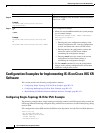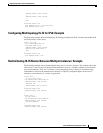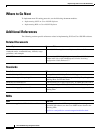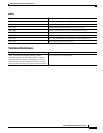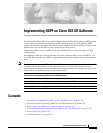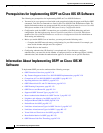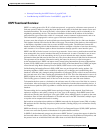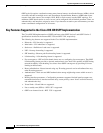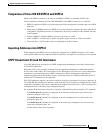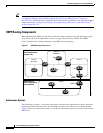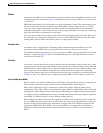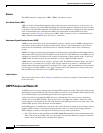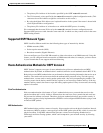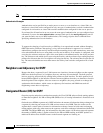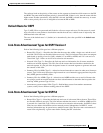
Implementing OSPF on Cisco IOS XR Software
Information About Implementing OSPF on Cisco IOS XR Software
RC-130
Cisco IOS XR Routing Configuration Guide
OSPF typically requires coordination among many internal routers: Area Border Routers (ABRs), which
are routers attached to multiple areas, and Autonomous System Border Routers (ASBRs) that export
reroutes from other sources (for example, IS-IS, BGP, or static routes) into the OSPF topology. At a
minimum, OSPF-based routers or access servers can be configured with all default parameter values, no
authentication, and interfaces assigned to areas. If you intend to customize your environment, you must
ensure coordinated configurations of all routers.
Key Features Supported in the Cisco IOS XR OSPF Implementation
The Cisco IOS XR implementation of OSPF conforms to the OSPF Version 2 and OSPF Version 3
specifications detailed in the Internet RFC 2328 and RFC 2740, respectively.
The following key features are supported in the Cisco IOS XR implementation:
• Hierarchy—CLI hierarchy is supported.
• Inheritance—CLI inheritance is supported.
• Stub areas—Definition of stub areas is supported.
• NSF—Nonstop forwarding is supported.
• SPF throttling—Shortest path first throttling feature is supported.
• LSA throttling—LSA throttling feature is supported.
• Fast convergence—SPF and LSA throttle timers are set, configuring fast convergence. The OSPF
LSA throttling feature provides a dynamic mechanism to slow down LSA updates in OSPF during
network instability. LSA throttling also allows faster OSPF convergence by providing LSA rate
limiting in milliseconds.
• Route redistribution—Routes learned using any IP routing protocol can be redistributed into any
other IP routing protocol.
• Authentication—Plain text and MD5 authentication among neighboring routers within an area is
supported.
• Routing interface parameters—Configurable parameters supported include interface output cost,
retransmission interval, interface transmit delay, router priority, router “dead” and hello intervals,
and authentication key.
• Virtual links—Virtual links are supported.
• Not-so-stubby area (NSSA)—RFC 1587 is supported.
• OSPF over demand circuit—RFC 1793 is supported.



